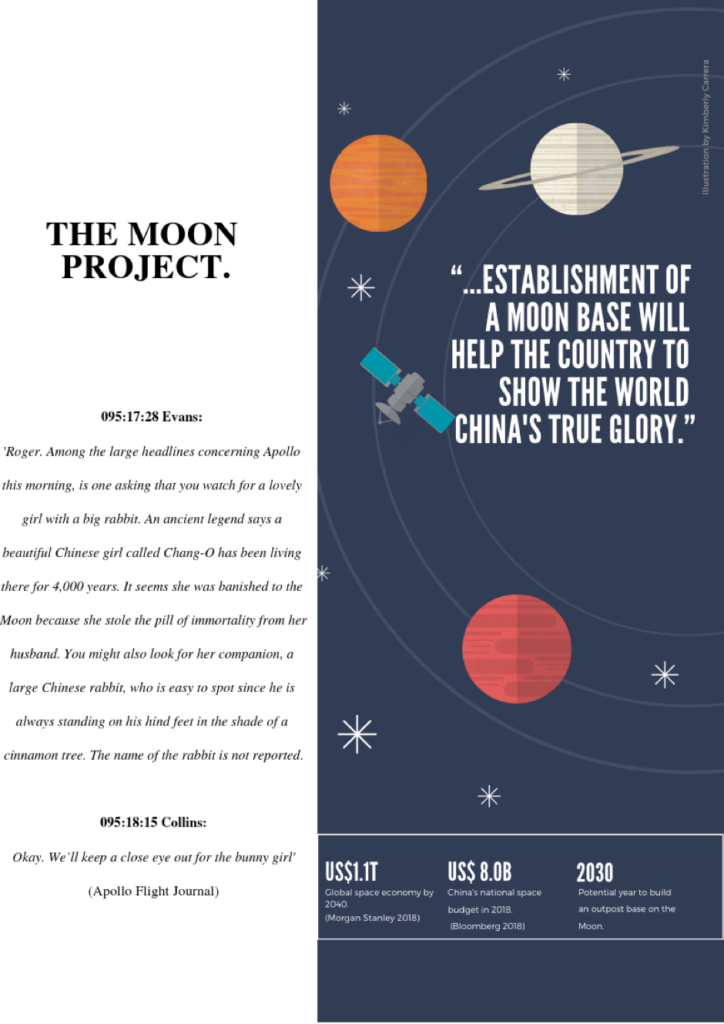Sign up to our newsletter to get updates on new articles.
China sees an advanced space program as a key economic driver for future economic growth and a stronger national identity.
On 5th of November 1960, China successfully launched its first ever rocket, becoming the fourth country to enter space, only after the US, USSR, and Germany. Although China’s economic state was dire at the time, the ambitious space program symbolized China’s growing desire to match its space might and capability with the US and USSR superpowers. Mao Zedong’s dream and vision were to have China’s space program to match those of the main superpowers. The prestigious status of being a powerful space nation was crucial for the Chinese Communist Party in Beijing in that era — the only problem was that China did not have the technological capability, human and economic resources at the time to develop its space program and needed foreign support and assistance.

The USSR, with its similar ideologies and political and economic systems, was the best candidate to assist China in developing its space program. Between the 1950s and 1960s was a period of strong Sino-Soviet cooperation. China on its part welcomed the USSR’s expertise in space technology and space launch.
After the death of Joseph Stalin in 1953, the Chinese Communist Party lost its confidence and ideological trust in its “older communist brother”. While the relationship was cooling off between China and the USSR, the Soviet Union withdrew all of their space scientists and technicians from China, leaving it to rely on its expertise, resources, and capabilities.
Since its first space launch, the Chinese space program was promising with plans to put a Chinese astronaut into space at the beginning of the 1970s. However, the space program suffered many political disruptions, mainly from the Cultural Revolution. Only in 1970 did the People’s Republic of China (PRC) launch its first satellite. There were also other announced projects, such as a human-crewed space capsule and a Skylab-type space station, however, most of these programs were later cancelled.
Modern Chinese Space Program.
The aftermath of the Cultural Revolution tremendously affected the social and economic conditions in China, including the space program. After Mao’s death in 1976, Deng Xiaoping returned and came into power. Deng initially invested little attention to the space industry. His focus was in promoting industries and as a result, shifted resources from military to more public projects, such as the launches of satellites for civil use. Deng also opened China to the West through a series of gradual market reforms.
By opening its doors to cooperation with foreign states, especially with the US, China managed to develop and improve its space launch technology. With assistance from the US, China also developed space launch and satellite recovery capabilities. The success rate was high, and by 2000, China had already developed and launched a large number of satellites, making it the fifth country in the world to independently develop and launch geostationary telecommunications satellites. China’s capability in utilising satellite recovery technology makes it the third country in the world, after the US and Russia. The opportunity to become a space superpower with advanced space capability has subsequently changed China’s foreign policy landscape, making it more influential.
The Chinese government has successfully managed to use its space activities as a pretext for more assertive foreign policy and China’s image in the world. The development of space technology and capabilities contributes to and aligns with China’s overall economic, military, foreign policy, and even social and cultural objectives.
On October 15, 2003, the PRC became the third nation to send a human into orbit.“Chinese Gagarin” Maj. Gen. Yang Liwei successfully landed an inaugural flight and immediately became a national hero. Chinese “taikonauts” have helped to promote the China brand both domestically and internationally.
Alongside the successful use of images of Chinese astronauts, rocket and satellite launches, the crucial aspect of increased nationalistic mood among the Chinese society has been Chinese economic might. Being the second largest economy in the world, China places itself in an advantageous position to invest more in space activities to match the US, Russia and the EU’s dominant positions in the space market. Since the 1990s, China has increased its investment in advanced space technology, which leads China to a better place in the world’s space market. China still has its Chang Zheng “Long March” rockets available for commercial purposes such as satellite launches.
By opening its doors to cooperation with foreign states, especially with the US, China managed to develop and improve its space launch technology. With assistance from the US, China also developed space launch and satellite recovery capabilities. The success rate was high, and by 2000, China had already developed and launched a large number of satellites, making it the fifth country in the world to independently develop and launch geostationary telecommunications satellites. China’s capability in utilising satellite recovery technology makes it the third country in the world, after the US and Russia.
The Moon Project.

The Chinese economic expansion and power have reached well beyond its borders. Today, China has economic interests and presence in all continents of the world. To feed the Chinese appetite for energy resources and further expand the economy, Beijing is keen to explore more alternative sources of its expansionism – the Moon. In the last few years, China committed significant investments towards its lunar projects (Project Chang’e) and would participate in other similar space activities.
The Chinese government sees the Moon as a challenge, an ultimate strategic and national goal, and an alternative source for energy. China’s lunar exploration program Project Chang’e consists of four main phases:

Phase I:
On October 24, 2003, the spacecraft Chang’e -1 was launched to probe the Moon and provide a detailed 3D map reference for future soft landings. After successfully completing the mission, it deorbited a year later and crashed on the Moon.
Phase II:
China deployed and soft-landed lunar rovers to explore the Moon and conduct observations for future research. The Chinese lunar program has proved to be a testament to China’s advanced scientific and technical capability. Although the missions were complex, China has managed to complete them successfully.
Phase III:
Chang’e 5-T1 was launched on 23 October 2014, and Chang’e 5 expected the launch in December 2019. This mission is most ambitious and incorporates the launch of a small rover to gather necessary first-ever lunar rock samples, return safely, and provide data for a future manned landing to establish a location for a permanent Chinese Moon base.
Phase IV:
This is the future phase for Chang’e 6, 7, and 8 with projected launches between 2023 and 2027. The main goal for the missions to research and collect samples of the Moon’s south pole.
China has been intensively promoting and broadcasting its lunar program domestically. During Phase III, the Chinese State TV released videos of Chang’e-3 and Chang’e-4 on the Moon and deployment of Yutu and Yutu-2 rovers. Most Chinese media channels were broadcasting these lifetime events across China. Such images are useful tools to increase pride and patriotism among Chinese society. This space activity is more symbolic, identifying a determination to achieve national independence, regional influence, and technological maturity, that in turn creates a national identity. Although the Moon project and other China’s space activities may be more symbolic, it is also viewed as a strong nationalistic message both domestically and internationally. China views the Moon program as strategic. It demonstrates China’s might in the space industry, its competitiveness and collaboration. In case China achieves successful human-crewed Moon landing, and the establishment of a Moon base will help the country to show the world China’s true glory.
China is in constant search of alternative energy resources. The emerging Chinese Moon mission looks to resolve the issue. For instance, many scientists and space researchers see the possibility of using helium-3 as a nuclear energy source. It is thought that the Moon has a greater amount of abandoned helium-3. In order to achieve secure access to the Moon and later to its vast energy resources, China has been engaged in developing and strengthening its space capabilities.
How to win the Moon battle?
China is not the only country interested in and actively developing space technologies to explore the Moon. India and Japan have also been investing in lunar missions. Alongside China’s Chang’e 5, India (Chandrayaan-2) and Japan (SLIM) have scheduled their missions to the Moon in 2019-2021. The “lunar” competition among the Asian states has also increased global interest in the Moon. It is likely that the US and the EU will invest in future lunar missions. Although there is an interest from the US, America has concentrated its attention on going beyond the Moon, for instance, exploring Mars and sending a manned mission to the red planet.
While the US Government’s lunar programs rely on corporations such as SpaceX, Astrobotic Technology, and MoonEx, China is working on overtaking India and Japan to become a dominant state in lunar space. Two phases of its Chang’e program were strategically planned and successfully executed, thus paving a path for the creation of a space superpower with potential spacefaring capability.
China has invested a significant amount of effort on improving its space technology and capability to ensure that its ambitious manned, Moon-landing mission succeeds. One of the key motivations for its manned missions to the Moon is to establish a permanent base on the Moon, with potential collaboration from other countries. In 2018, The China National Space Administration (CNSA) and the Russian State Space Corporation (Roscosmos) signed a joint agreement on intent for cooperation in exploring the Moon and the Outer space. The dominance in the space between the Earth and the Moon, will give China a strategic advantage and continue to bolster its national identity.
Sign up to our newsletter to get updates on new articles.





